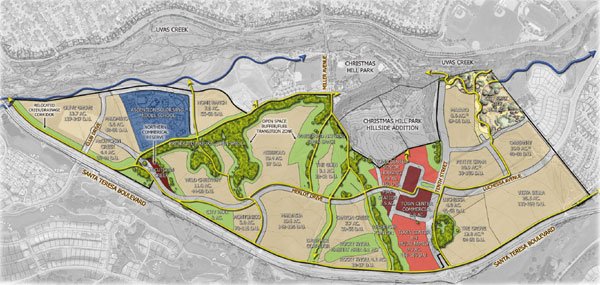The Filice family’s ambitious plans to build the biggest housing
development in Gilroy history have been slowed by a stream of
obstacles, including union threats and two rounds of environmental
challenges.
Gilroy – The Filice family’s ambitious plans to build the biggest housing development in Gilroy history have been slowed by a stream of obstacles, including union threats and two rounds of environmental challenges. But now, after six years and $2 million spent polishing designs, city leaders are eager to move forward with Glen Loma Ranch, a mini-city that will spread over 360 acres in Gilroy’s southwest region.
“I think it’s a terrific project,” said Councilman Bob Dillon, who as a member of the Neighborhood District Policy Task Force has seen the project evolve in step with the city’s vision for meticulous pre-planning.
Members of the Glen Loma team worked with the task force over the last two years, molding their designs to emerging guidelines on affordable housing, diverse housing types, open space and other policy goals.
“For as long as they’ve been working on this project, it has been consistent with the new neighborhood district policy,” city planner Cydney Casper said. “They’ve been very active and involved in the task force working on that policy so they’ve incorporated this from the inception. I think they’ve done a very good job of meeting the intent. I think it’s going to set a good precedent.”
The Glen Loma Specific Plan lays out a vision for nearly 1,700 homes, an elementary school, a shopping area, road extensions, and a network of open space and trails. It includes 18 neighborhoods that mix single family homes, duplexes, and a new style of multi-family home known as a manor house.
“This is really the flagship for us,” said Tim Filice, one of five family members chosen as a project manager by his relatives. The Filice clan spans three generations, five separate families, and includes more than 100 relatives.
“We grew up on this property,” Filice said. “We have a strong feeling for it and we want to see it done properly.”
Since 1930, much of what is now known as Glen Loma Ranch has been in the Filice family. Over the years, family members have proposed several plans to develop the land, but “until 1999, the city said it was premature,” according to Filice.
That year, councilmen allotted the Filice group 30 permits “to signal to us that the time for Glen Loma was near.” Two years later, city leaders signed off on nearly 1,400 more building permits to be spread over a 10-year period.
Combined with several hundred permits transferred from other projects, the Glen Loma development has eaten up roughly half of the available housing permits for the next decade.
Just as the project began to pick up momentum, the Glen Loma group encountered a new challenge in the form of strong-arm tactics by local workers. Two years ago, local unions sidelined the project by filing a 200-page environmental protest, a move intended to extract guarantees that only union workers would be allowed to build the project’s homes.
The Glen Loma group has spent the intervening time adjusting plans to meet environmental concerns, and they believe the new environmental impact report, issued in May, will stand up to scrutiny.
A new set of critics have emerged this time around, although they have stopped short of outright opposition.
Carolyn Tognetti, spokesperson for local environmental group Save Open Spaces, said members plan to raise a number of issues at public hearings beginning in October. Their chief concern centers on the potential loss of farmland as part of the project.
The latest environmental impact report released in May concluded that the Glen Loma property, which has not been irrigated for 26 years, is no longer viable as “prime farmland.” That assessment differs with maps drawn in the last four years by the state conservation department, and SOS has asked for further review to resolve discrepancies.
“It’s kind of a complicated formula of things they look at to figure out if land is considered prime farmland,” Tognetti said. “But if it is, they have to call (the project) a ‘significant impact’ and do some sort of mitigation.”
According to the city policy, mitigation would require preserving the land or purchasing property elsewhere as a replacement.
“It’s not like we’re totally against the project,” Tognetti added, pointing out a number of positive aspects that go beyond environmental concerns. “It’s being planned very well with the neighborhood district concept. They’re leaving a lot of open space in the form of gullies and riparian corridors … And then the mix of housing is important, so that all incomes can live out there.”
The Glen Loma project is expected to unfold over the course of the next decade, according to Filice. Neighborhoods will sprout up from the outer edges, starting with two neighborhoods south of Christmas Hill Park followed shortly after by Home Ranch, a housing cluster by Ascencion Solorsano Middle School.
Project representatives intend to shepherd the Glen Loma Specific Plan, the broad-based guidelines for the entire 360-acre area, through the regulatory process at the same time as detailed plans for the first few neighborhoods. Planning commissioners will begin reviewing plans in mid-September, and councilmen hope to begin their review by November. Filice expected the first homes to be on the market by 2007.
Reflecting on the need to pre-plan hundreds of acres before a single home is ever built, Filice revealed a hard-earned belief: “Yes it’s time-consuming, yes it’s expensive. But it’s really the way things should be done.”















